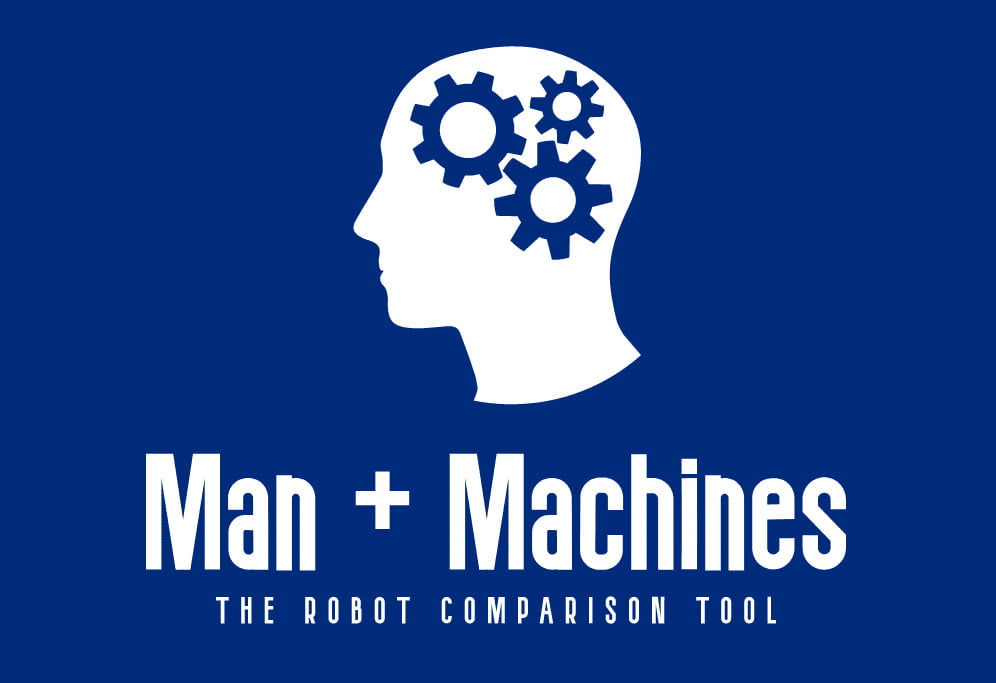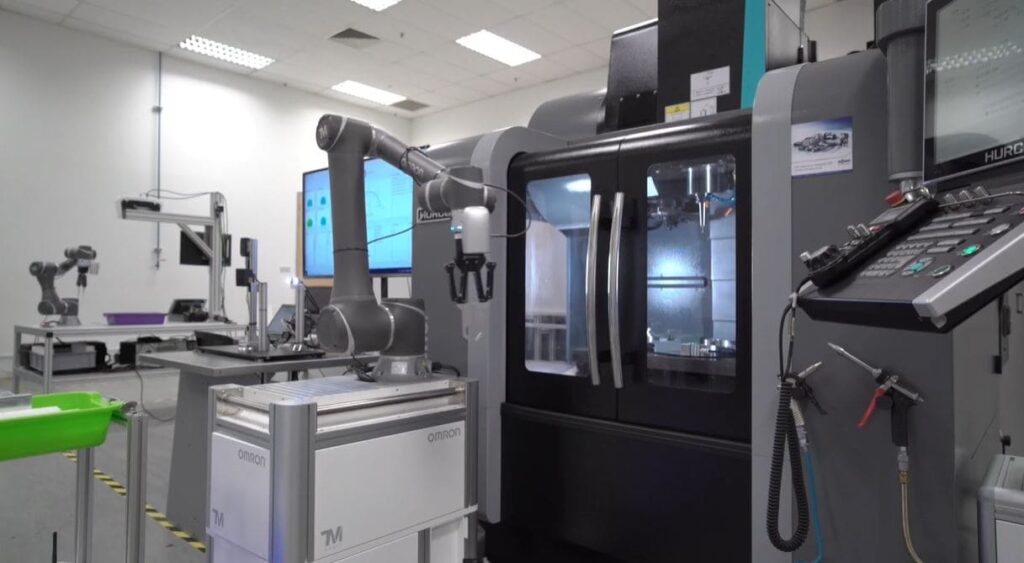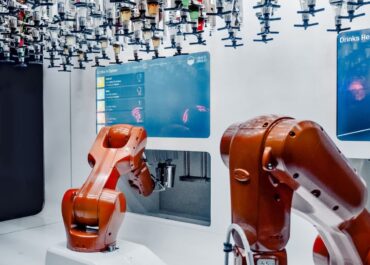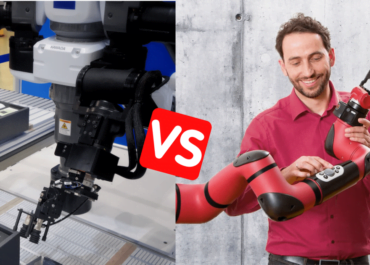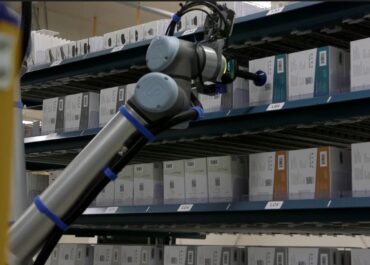During their workshift, machining technicians need to load and unload parts constantly. This often means physical stress and risk of injury at their workstation. It can also distract them from crafting more sophisticated parts.
Collaborative robots are the ideal automation solution to relieve the burden on these workers. Thanks to their flexibility and compact design, they reliably assist factory workers.
But which cobot or robotic kit to choose and integrate into your machining processes?
Here is a guide to the best offers on the market and our informed advice on the subject.
Why use cobots for machine tending ?
Whether it’s a CNC, injection molding, drilling, or milling machine, maintaining these tools is a particularly tiring and dangerous task. It can be especially difficult for a plant manager to convince workers to lift heavy parts all day.
So it’s no wonder that automating these applications has become a recurring problem in all industrial sectors. Relating to this issue, collaborative robots have proven to be a valuable asset.
Cobots can easily learn to pick up and put down these objects without friction and mistakes. They can perform the same gesture thousands of times, night and day. With proven safety, workers can delegate this repetitive task and focus on making quality parts.
In addition, unlike traditional automation, cobots are inexpensive and can be easily redeployed and reprogrammed to different types of machines.
As a result, collaborative robots may interest you for several reasons:
- Improving the working conditions of your machining operators, including assisting with part loading and avoiding injuries.
- Increasing the efficiency of your machining outputs, day and night.
- Saving time for your machinists and millers, so they can work on higher value parts.
If this relates to you, here is a guide to choose and integrate a robotic system for your machine maintenance.
Cobot for machining : a top 5
Most collaborative robots on the market can handle machine tool maintenance. But not all of them have the same facility to carry heavy parts or to open the door of the machine tool. Here are the most suitable models for this application:
Universal Robot

The king of collaborative robots, Universal Robot has historically differentiated itself on machine maintenance applications. With their versatility and speed of deployment, their UR models load and unload any type of machine in no time. There are many reasons why they are so popular for this type of work:
- Any machining technician can easily program them.
- A compact design that fits into tight spaces and allows for easy movement.
- Accurate repeatability of movement to avoid errors, as well as a constant operating speed.
- Force sensors that ensure operator safety at the workstation.
- Compatibility with many end effectors
OB7 Productive Robotics

As a newcomer to the cobot market, the OB7 models from Productive Robotics have set themselves apart by being one of the easiest to deploy. All an operator has to do is to demonstrate the gesture, and the robot will learn the process automatically. That way, it can load a machine, open a door or press a button in no time. OB7 models, therefore, show strong selling points:
- One of the most intuitive task programming on the market.
- With their 7ᵉ axis, they can handle doors, parts and buttons with more agility.
- Great redundancy of movements that improves machining efficiency.
- Insured safety for operators on site with built-in sensors.
Omron TM

Omron collaborative robots are also productive solutions for machining applications. With their integrated vision module, they can adapt to any type of part and machine to do their job accurately. But they have other advantages:
- Smart vision that can detect landmarks to fit any machine shop.
- They can set up on mobile devices to quickly move from one machine to another.
- The robots have an innovative safety mode to allow a closer collaboration with the operators.
Yaskawa Motoman HC

The Motoman group has a long experience in machining automation. Their Motoman HC series especially provide flawless productivity on this kind of application. With their high specifications and technical performance, they can carry high volume parts and loads without fail. They offer many interesting features:
- Collaborative safety features that allows them to run at a high speed, then adjust their speed when collaborators are at reach.
- Technical performance and specs (reach, load and speed) that allow them to handle large parts.
- Intuitive learning features to program the robot easily.
Kassow KR

As part of the latest generation of robots, Kassow cobot models demonstrate a solid and well-thought-out technical build. Their load, reach and speed capabilities combined with a compact and lightweight design show very convincing performance in specialized machine maintenance. This is especially attractive with:
- A 7ᵉ travel axis that allows robots to reach more inaccessible corners, even more so with models with very long reaches (1800 mm).
- A load capacity and speed that offers one of the best productivity on the market on bulky parts. At the same time, a light design that makes it easy to move.
- A programming interface that allows to manage more complex loops or cycles.
What are the best robotic kits for machine loading?
Most manufacturers have partnered with distributors to offer application-specific robotic kits. Machining is no exception to the rule, and many packages deliver both a collaborative robot, a suitable end effector, and a mounting flange. Here are the best ones on the market:
Robotiq

Robotiq is a company known for making high-quality cobotic end effectors. Their machine maintenance kit is outstanding, combining a dual gripper, UR robot, optional camera, and cycle optimization software. The dual grippers are very well-designed for gripping objects and increasing task efficiency. Meanwhile, the built-in camera allows the robot to adapt to any new configuration.
EMI

EMI is an industrial group that has long proven its expertise in manufacturing robotic tools. Their metal gripper kits with 2 or 3 parallel or concentric jaws allow customization according to your needs. The kits can also include an air blower or a force sensor to make the application more efficient. These are reliable solutions for moving your bulky parts.
OnRobot

Competitors to Robotiq, OnRobot end effectors also show great compatibility with machine loading. Their wide range of grippers adapts to many configurations and object volumes for optimal gripping. They can also come with a dual tool changer, force sensor, or camera module to make the application more precise.
ProCobots

The company ProCobot offers complete machine maintenance robotic devices. Besides collaborative robots and end effectors, it also provides a wide range of part feeders, mounting brackets, and mobile devices. Thus, you can have all the necessary solutions to build your machining robotic cell.
Schunk

The company Schunk also makes grippers very good at machining parts. For example, their Co-Act model is very popular for collaborative applications. Their design allows fast setup and strongly grips objects. Manufacturers like Fanuc offer them in kit with their collaborative robot.
How to integrate cobots into your machining processes?
Planning the automation of an industrial application requires meticulous organization. Here is a step-by-step guide to choosing and integrating your robotic system into your machining processes.
1. Defining your needs
To begin with, consider the goals of your automation project. Do you need cobots primarily to relieve your machining operators, increase the throughput of your continuous machining processes, or assist your agents on more sophisticated parts?
2. Choosing the right device
Based on these goals, you can then define your preferences regarding cobot models or machining kits.
There are many factors that you might consider:
- Reach capabilities compared to your workshop configuration
- Part weight and therefore the necessary robot load
- Gripping precision adapted to the shape of your parts…
- You may also want to focus on the safety features, the ease of deployment and programming….
Depending on the value you place on those features, you can then select the cobot and end effector best suited to your needs.
3. Redesigning the machining cell
Once you have purchased the right robotic machining solution, you can then think about integrating it into your existing cell. This often involves reconfiguring the space and devices on your shop floor. For example, you might want to give workers more room to change applications, or add part feeders or mobile stands.
4. Rethinking work organization
You need also to reconsider the workflow of your employees and their contribution. What will be the new role of machining operators in your collaborative application? Supervisors, who monitor and adjust the robot workload? Or independent agents who can now focus on machining higher quality parts?
5. Conducting a risk assessment
Prior to the deployment, you should also conduct a risk assessment of your new application. Even though collaborative robots can prevent potential collisions, you need to anticipate the contact points, whether with the robot, the parts, or the machining center. These different interactions can involve more complex work dynamics that your employees need to be aware of.
6. Organizing employee training
Finally, you need to organize your employees’ training for these new tools. Even though these collaborative robots are easier to use than other devices, you still need to know how they work. Special emphasis should be placed on safety protocols and functionality. This will help build trust with employees.
So now you have everything you need to select and implement your robotic solution in your machining cell. And if you want more information on the right cobot model, check out our guide.
